Our Family Returns to Taiwan to Join a 2nd AADC Deficiency Study
Researchers aim to understand the long-term effectiveness of gene therapy

Last October, news began to circulate that Taiwan was reopening for tourism after lifting pandemic restrictions. Usually my family would celebrate an opportunity to travel; instead, this news meant continuing our obligation to contribute data to medical research.
On Nov. 13, 2019, our daughter, Rylae-Ann, underwent experimental gene therapy in Taiwan to treat her aromatic l-amino acid decarboxylase (AADC) deficiency. We now refer to it as her “reborn day.” Although we lived in Singapore then, we’d planned on having Rylae-Ann remain in Taiwan for six months while my wife and I took turns flying back and forth.
In January 2020, it was my turn to fly to Taiwan. Upon landing, passengers were subjected to various screenings due to a mysterious illness. As a result, Taiwan’s healthcare system was put on red alert; all nonessential care was closed, and the hospital implemented a strict entry protocol that would become a regular practice for most of us.
There hadn’t been any word about this illness when I left Singapore, so I thought the island country was overreacting. I didn’t complain, however, because it meant my daughter would leave the trial and come home early.
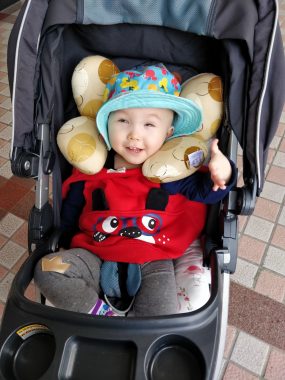
Rylae-Ann, a few days after receiving gene therapy in November 2019. (Courtesy of Richard E. Poulin III)
Gene therapy approval
Later, we’d learn that this mysterious illness was COVID-19. The clinical trial closed, despite my daughter only contributing three months of data. Today, that gene therapy is known as Upstaza (eladocagene exuparvovec) and has been authorized to treat AADC-deficient children 18 months and older in the U.K. and Europe.
However, the journey toward worldwide approval continues, meaning our family needs to do our part. Returning to Taiwan would mean subjecting our daughter to more testing, but gene therapy gave her a chance to live. We want the same for all families in our community, so last October, we began to plan a trip to Taiwan.
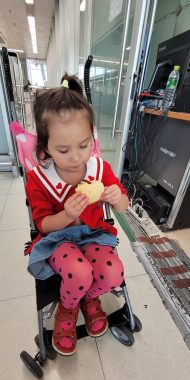
Rylae-Ann patiently waits and enjoys a snack while going through immigration. (Courtesy of Richard E. Poulin III)
Joining a new study
The clinical trial our daughter initially participated in had closed, but we knew other participants were still visiting the hospital. After talking with the team at National Taiwan University Hospital, we learned they were conducting a long-term study on the effectiveness of Upstaza. Again, we completed the paperwork to join the study, and in December we hopped on an airplane to Taiwan.
We landed late in the evening and promptly slept after arriving at the hotel. Before the sun was up, we woke and headed to the hospital to begin.
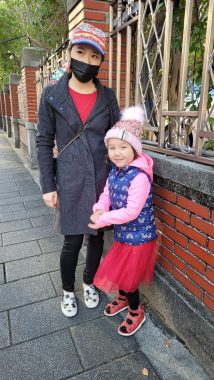
Mom and Rylae-Ann are on the way to the hospital after landing the previous night in Taiwan. (Courtesy of Richard E. Poulin III)
Initial tests
Over the past few years, we’ve been working on minimizing our daughter’s pediatric medical traumatic stress surrounding hospitals. She has improved dramatically. Although she was still extremely nervous, Rylae-Ann visited various stations at the hospital to complete assessments for speech, nutrition, vital signs, height, weight, and other routine checks.
We finished before dinner, but Rylae-Ann would need to stay at the hospital on Christmas Eve. She’d begin the invasive testing the next morning. Only one parent could stay, so I took over the watch. I wanted to be with her for the challenging assessments, and my wife struggles to see our daughter in pain.
I enjoyed the night with Rylae-Ann. We had a large dinner together because she wouldn’t be allowed anything by mouth the next day until all the tests were complete. We brought several stockings filled with goodies and made our rounds, going through the pediatric patient ward and giving gifts to children admitted. As my daughter slept, I remembered being one of those parents, three years ago to the day.

Nurses attend to Rylae-Ann on the first day to complete one of many tests. (Courtesy of Richard E. Poulin III)
Invasive tests
As soon as my daughter woke on Christmas morning, she had an IV placed in her and several vials of blood drawn. Surprisingly, she didn’t cry at all until the blood entered the syringe. Then I had to apply a bear hug using dad strength to allow the nurse to finish without issues.
She calmed down after, but relaxed significantly once the doctors gave her a sedative. The doctors and I spent a few minutes waiting for her to fall asleep. Everyone was charmed by her antics in her sleepy state.
Once she was out, the doctors collected cerebral spinal fluids, X-rays, and CT scans. The team was efficient, and Rylae-Ann was back in her room in a few hours. She woke sluggish, but was able to eat her first meal of the day. We both slept well that evening.
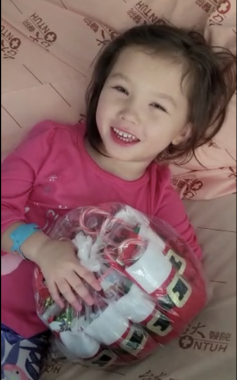
Rylae-Ann prepares to hand out stockings with goodies to other children in the pediatric ward on Christmas Eve. (Courtesy of Richard E. Poulin III)
Final day
My wife stayed with Rylae-Ann the next day for the remaining physical therapy, occupational therapy, and cognitive tests. Even though Rylae was still recovering, I was confident she’d demonstrated how helpful gene therapy can be for those with AADC deficiency.
Before leaving the hospital, five AADC-deficient children got to meet one another. They ranged in age and were from different countries, yet they all got to hold hands and bond. As parents, it was a fantastic feeling to meet face to face and a great way to culminate our trip. We shared our struggles, but we also made beautiful memories.
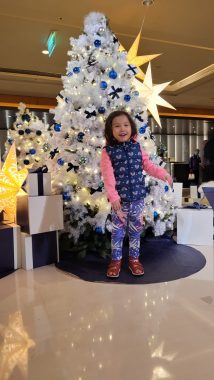
On Christmas, Rylae-Ann completed tests to contribute data for a clinical trial on the long-term effectiveness of gene therapy. (Courtesy of Richard E. Poulin III)
Note: AADC News is strictly a news and information website about the disease. It does not provide medical advice, diagnosis, or treatment. This content is not intended to be a substitute for professional medical advice, diagnosis, or treatment. Always seek the advice of your physician or other qualified health provider with any questions you may have regarding a medical condition. Never disregard professional medical advice or delay in seeking it because of something you have read on this website. The opinions expressed in this column are not those of AADC News or its parent company, BioNews, and are intended to spark discussion about issues pertaining to aromatic l-amino acid decarboxylase deficiency.







Comments